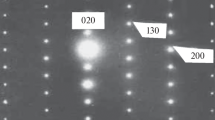Summary
Vertumnite, Ca4Al4Si4O6(OH)24·3H2O, is metrically monoclinic, strongly pseudohexagonal;a=5.744 (5),b=5.766(5),c=25.12(1) Å, γ=119.72(5)°; space groupP2 1 /m. The crystal structure was determined from X-ray intensities and refined in both the monoclinic and the hexagonal space group [P6 3/m; a=(a mon +b mon )/2]. The monoclinic refinement did not lead to significant deviations from hexagonal symmetry. The atomic arrangement consists of modified brucite-layers Ca VII2 AlVI(OH, H2O)8, atz=0 andz=1/2, alternating with tetrahedral double layers and connected only by hydrogen bridges. TheT sites are statistically and only partly occupied by Si and Al. The distances from theT sites to the three basal (O, OH) measure 1.80 Å; this large distance is probably caused by local deformations in connection with the disorder in theT sites. Water molecules occupy statistically the double rings. A comparison with the previously reported powder patterns of “gehlenite hydrate” and strätlingite is given.
Zusammenfassung
Vertumnit, Ca4Al4Si4O6(OH)24·3 H2O, ist metrisch monoklin, ausgeprägt pseudohexagonal;a 0=5,744(5),b 0=5,766(5),c 0=25,12(1) Å, γ=119,72(5)°; RaumgruppeP2 1/m. Die Kristallstruktur wurde aus Röntgenintensitäten bestimmt und sowohl in der monoklinen wie in der hexagonalen Raumgruppe [P6 3/m; a 0=(a 0,mon +b 0,mon )/2] verfeinert. Die monokline Verfeinerung führte auf keine wesentlichen Abweichungen von hexagonaler Symmetrie. Die Atomanordnung besteht aus modifizierten Brucit-Schichten, Ca VII2 AlVI(Oh, H2O)8, die mit Doppeltetraederschichten abwechseln und mit diesen nur über Wasserstoffbrücken verbunden sind. DieT-Positionen sind durch Si und Al statistisch und nur partiell besetzt. Die Abstände von denT-Positionen zu den drei basalen (O, OH) messen 1,80 Å; dieser große Abstand wird wahrscheinlich durch lokale Verzerrungen im Zusammenhang mit der Unordnung in denT-Lagen verursacht. Wassermoleküle füllen statistisch die Doppelringe. Das Pulverdiagramm wird mit den publizierten Diagrammen von “Gehlenit-Hydrat” und Strätlingit verglichen.
Similar content being viewed by others
References
Abrahams, S. C., 1969: Indicators of accuracy in structure factor measurement. Acta Cryst.A25, 165–173.
Ahmed, S. J., andH. F. W. Taylor, 1967: Crystal structures of the lamellar calcium aluminate hydrates. Nature215, 622–623.
Allmann, R., 1968: Die Doppelschichtstruktur der plättchenförmigen Calcium-Aluminium-Hydroxisalze am Beispiel des 3 CaO·Al2O3·CaSO4·12H2O. N. Jb. Min. Mh., Jg.1968, 140–144.
Busing, W. R., K. O. Martin, andH. A. Lévy, 1962: ORFLS. A Fortran crystallographic least-squares refinement program. U. S. Nat. Tech. Inform. Serv. ORNL-TM-305.
Davies, J. E., andB. M. Gatehouse, 1973: The crystal and molecular structure of unsolvated μ-Oxo-bis-[N,N′-ethylenebis(salicylaldiminato)iron(III)]. Acta Cryst.B29, 1934–1942.
Drits, V. A., A. A. Kashaev, andG. V. Sokolova, 1975: Crystal structure of cymrite. (In Russian). Kristallografiya20, 280–286. [Translation in Sov. Phys. Cryst.20, 171–175].
Hamilton, W. C., 1959: On the isotropic temperature factor equivalent to a given anisotropic temperature factor. Acta Cryst.12, 609–610.
Hanson, H. P., F. Herman, J. D. Lea, andS. Skilmann, 1964: HFS atomic scattering factors. Acta Cryst.17, 1040–1044.
Hentschel, G., andH.-J. Kuzel, 1976: Strätlingit, 2 CaO·Al2O3·SiO2·8 H2O, ein neues Mineral. N. Jb. Min. Mh., Jg.1976, 326–330.
Kuzel, H.-J., 1976: Crystallographic data and thermal decomposition of synthetic gehlenite hydrate 2 CaO·Al2O3·SiO2·8 H2O. N. Jb. Min. Mh. Jg.1976, 319–325.
Louisnathan, S. J., andG. V. Gibbs, 1972: Aluminum-silicon distribution in zunyite. Amer. Min.57, 1089–1108.
Main, P., M. M. Woolfson, andG. Germain, 1971: MULTAN, a computer program for the automatic solution of crystal structures. University of York.
Miyashiro, A., 1956: Osumilite, a new silicate mineral, and its crystal structure. Amer. Min.41, 104–116.
Moore, P. B., 1970: Edge-sharing silicate tetrahedra in the crystal structure of leucophoenicite. Amer. Min.,55, 1146–1166.
Passaglia, E., andE. Galli, 1977: Vertumnite, a new natural silicate. Tschermaks Min. Petr. Mitt.24, 57–66.
Schmitt, C. H., 1960: Discussion of “Hydratation of calcium aluminates and ferrites” by F. E. Jones. Proc. Fourth Int. Symp. on the Chem. of Cement, Washington I, 244.
Schulz, H., andP. J. Huber, 1971: Dispersion analysis of single-crystal diffractometer measurements. I. Methods of investigation. Acta Cryst.A27, 536–539.
Takéuchi, Y., 1958: A detailed investigation of the structure of hexagonal BaAl2Si2O8 with reference to its α-β inversion. Min. J.2, 311–332.
Takéuchi, A., andG. Donnay, 1959: The crystal structure of hexagonal CaAl2Si2O8. Acta Cryst.12, 465–470.
Taylor, H. F. W., 1974: Crystal chemistry of portland cement hydration products. Sixth Internat. Symposium on the chemistry of Cement, Moscow, Principal Paper.
Author information
Authors and Affiliations
Additional information
With 2 Figures
Rights and permissions
About this article
Cite this article
Galli, E., Passaglia, E. Vertumnite: Its crystal structure and relationship with natural and synthetic phases. TMPM Tschermaks Petr. Mitt. 25, 33–46 (1978). https://doi.org/10.1007/BF01082202
Received:
Accepted:
Issue Date:
DOI: https://doi.org/10.1007/BF01082202




